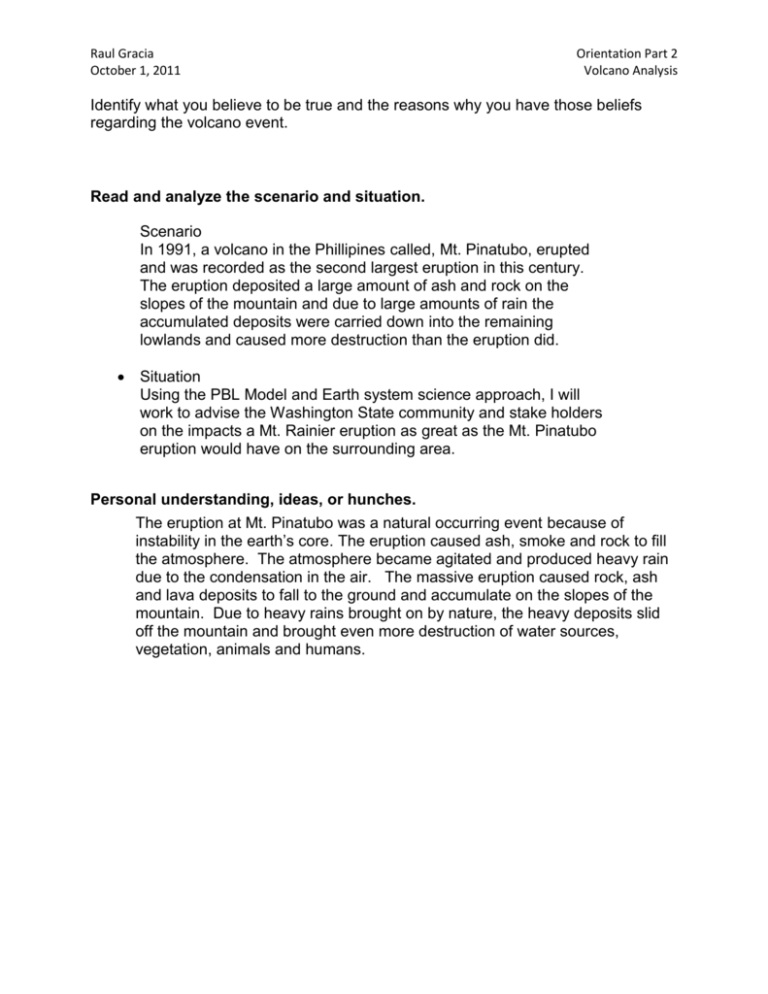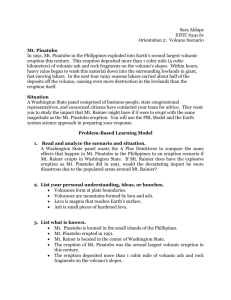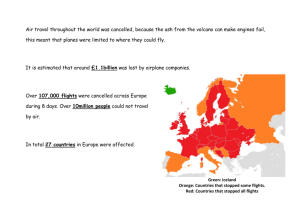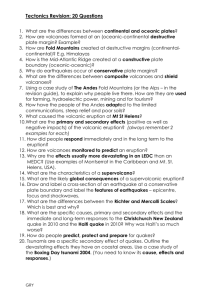Raul Gracia Orientation Part 2 October 1, 2011 Volcano Analysis
advertisement

Raul Gracia October 1, 2011 Orientation Part 2 Volcano Analysis Identify what you believe to be true and the reasons why you have those beliefs regarding the volcano event. Read and analyze the scenario and situation. Scenario In 1991, a volcano in the Phillipines called, Mt. Pinatubo, erupted and was recorded as the second largest eruption in this century. The eruption deposited a large amount of ash and rock on the slopes of the mountain and due to large amounts of rain the accumulated deposits were carried down into the remaining lowlands and caused more destruction than the eruption did. Situation Using the PBL Model and Earth system science approach, I will work to advise the Washington State community and stake holders on the impacts a Mt. Rainier eruption as great as the Mt. Pinatubo eruption would have on the surrounding area. Personal understanding, ideas, or hunches. The eruption at Mt. Pinatubo was a natural occurring event because of instability in the earth’s core. The eruption caused ash, smoke and rock to fill the atmosphere. The atmosphere became agitated and produced heavy rain due to the condensation in the air. The massive eruption caused rock, ash and lava deposits to fall to the ground and accumulate on the slopes of the mountain. Due to heavy rains brought on by nature, the heavy deposits slid off the mountain and brought even more destruction of water sources, vegetation, animals and humans. Raul Gracia October 1, 2011 Orientation Part 2 Volcano Analysis List what is known. It is known that the eruption was the 2nd largest this century. The eruption deposited more than 1 cubic mile (5 cubic kilometers) of volcanic ash and rock fragments on the volcano's slopes. Heavy rain caused the deposits to slide off the slopes and cause more destruction. E>A: The eruption at Mt. Pinatubo caused a massive explosion and spewed ash and rock into the atmosphere. The smoke and heat caused clouds to form and heavy rain to fall. E>B: The flowing lava, falling ash and rock destroyed vegetation, animals and humans in the lowlands occupying the base of the mountain. E>H: The flowing lava, falling ash and rock destroyed water sources and polluted surrounding rivers. E>L: The large amounts of volcanic deposits that covered the mountain after the eruption slid into the lowlands after heavy rains and covered the soil making it rich with nutrients but destroying existing flora. List what is unknown. When comparing the eruption on Mt. Pinatubo to a possible eruption on Mt. Rainier, I think one must take the following into consideration: o What are the geographic locations of both mountains? o What is the population count in the areas where each mountain is? o What were the effects that occurred in the former’s aftermath? o How did the eruption affect the surrounding environment? o Where can the data on the eruption that needs to be analyzed to find out the magnitude of the eruption and the status of the mountain’s inner workings days, months and even years before the eruption be found? o What is the current data on Mt. Rainier o How active is Mt. Rainier o Is Mt. Rainier Extinct? o What are the evacuation routes for Washington State in case of an eruption? Raul Gracia October 1, 2011 Orientation Part 2 Volcano Analysis List what needs to be done. To be able to determine what the impacts would be on Washington State from a Mt. Rainier eruption as compared to the Mt. Pinatubo eruption a volcanologist, a geologist, and online research would need to be utilized to answer the unknown questions conceived and backup the known information listed. Develop a problem statement. Possible Problem Statement would be - After acquiring expert and critical data analysis on the Mt. Pinatubo eruption, a presentation would be created for a Washington State Panel on the comparison of the effects of a possible Mt. Rainier eruption on the surrounding communities and environment. Gather information. Present findings.







